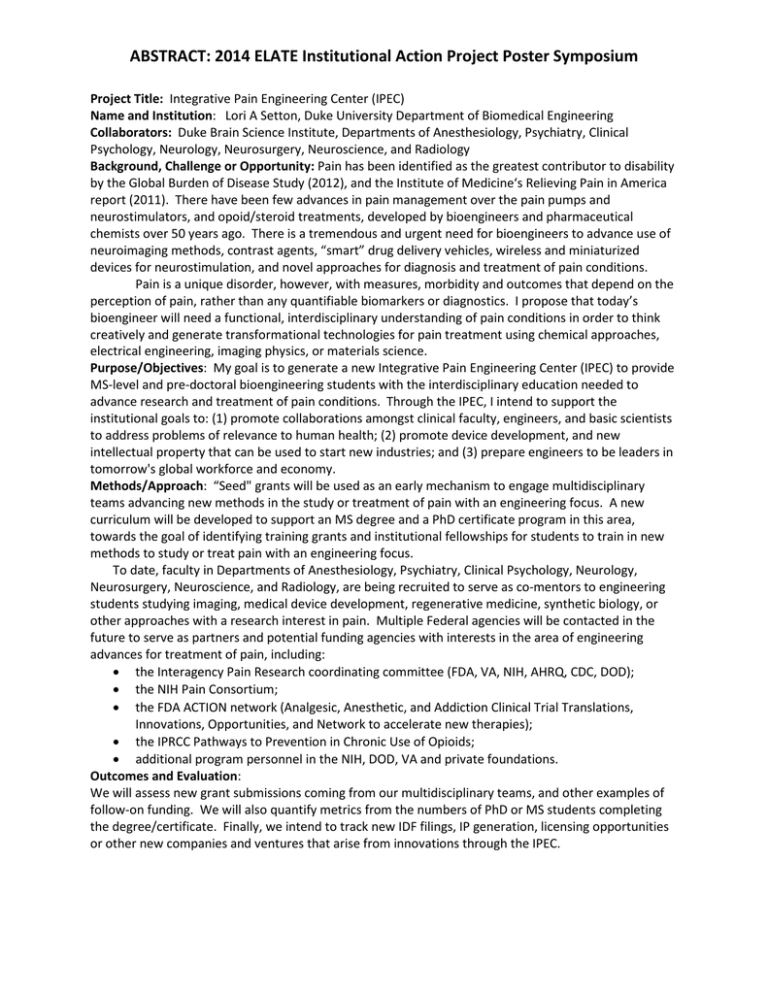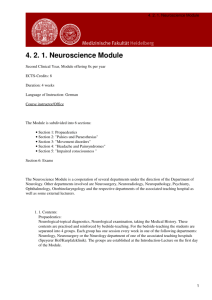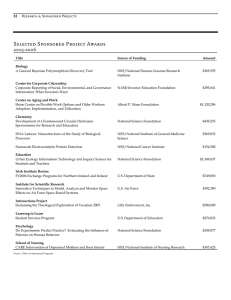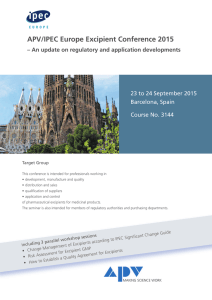ABSTRACT: 2014 ELATE Institutional Action Project Poster Symposium
advertisement

ABSTRACT: 2014 ELATE Institutional Action Project Poster Symposium Project Title: Integrative Pain Engineering Center (IPEC) Name and Institution: Lori A Setton, Duke University Department of Biomedical Engineering Collaborators: Duke Brain Science Institute, Departments of Anesthesiology, Psychiatry, Clinical Psychology, Neurology, Neurosurgery, Neuroscience, and Radiology Background, Challenge or Opportunity: Pain has been identified as the greatest contributor to disability by the Global Burden of Disease Study (2012), and the Institute of Medicine‘s Relieving Pain in America report (2011). There have been few advances in pain management over the pain pumps and neurostimulators, and opoid/steroid treatments, developed by bioengineers and pharmaceutical chemists over 50 years ago. There is a tremendous and urgent need for bioengineers to advance use of neuroimaging methods, contrast agents, “smart” drug delivery vehicles, wireless and miniaturized devices for neurostimulation, and novel approaches for diagnosis and treatment of pain conditions. Pain is a unique disorder, however, with measures, morbidity and outcomes that depend on the perception of pain, rather than any quantifiable biomarkers or diagnostics. I propose that today’s bioengineer will need a functional, interdisciplinary understanding of pain conditions in order to think creatively and generate transformational technologies for pain treatment using chemical approaches, electrical engineering, imaging physics, or materials science. Purpose/Objectives: My goal is to generate a new Integrative Pain Engineering Center (IPEC) to provide MS-level and pre-doctoral bioengineering students with the interdisciplinary education needed to advance research and treatment of pain conditions. Through the IPEC, I intend to support the institutional goals to: (1) promote collaborations amongst clinical faculty, engineers, and basic scientists to address problems of relevance to human health; (2) promote device development, and new intellectual property that can be used to start new industries; and (3) prepare engineers to be leaders in tomorrow's global workforce and economy. Methods/Approach: “Seed" grants will be used as an early mechanism to engage multidisciplinary teams advancing new methods in the study or treatment of pain with an engineering focus. A new curriculum will be developed to support an MS degree and a PhD certificate program in this area, towards the goal of identifying training grants and institutional fellowships for students to train in new methods to study or treat pain with an engineering focus. To date, faculty in Departments of Anesthesiology, Psychiatry, Clinical Psychology, Neurology, Neurosurgery, Neuroscience, and Radiology, are being recruited to serve as co-mentors to engineering students studying imaging, medical device development, regenerative medicine, synthetic biology, or other approaches with a research interest in pain. Multiple Federal agencies will be contacted in the future to serve as partners and potential funding agencies with interests in the area of engineering advances for treatment of pain, including: • the Interagency Pain Research coordinating committee (FDA, VA, NIH, AHRQ, CDC, DOD); • the NIH Pain Consortium; • the FDA ACTION network (Analgesic, Anesthetic, and Addiction Clinical Trial Translations, Innovations, Opportunities, and Network to accelerate new therapies); • the IPRCC Pathways to Prevention in Chronic Use of Opioids; • additional program personnel in the NIH, DOD, VA and private foundations. Outcomes and Evaluation: We will assess new grant submissions coming from our multidisciplinary teams, and other examples of follow-on funding. We will also quantify metrics from the numbers of PhD or MS students completing the degree/certificate. Finally, we intend to track new IDF filings, IP generation, licensing opportunities or other new companies and ventures that arise from innovations through the IPEC.











